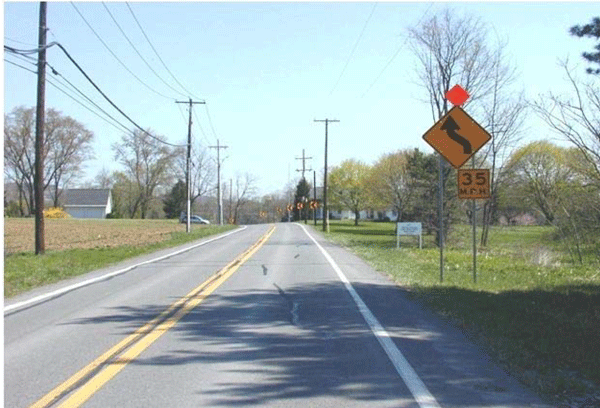U.S. Department of Transportation
Federal Highway Administration
1200 New Jersey Avenue, SE
Washington, DC 20590
202-366-4000
| < Previous | Table of Contents | Next > |
A higher percentage of fatal curve-related crashes occur on rural roads–particularly on two-lane rural roads–due largely in part to the predominance of horizontal curves on typical rural roads. In 2013, more than 13 percent of fatal crashes in Pennsylvania occurred due to Curve Driver Error Crashes, many of which involved roadway departures. To address curve-related crashes, the Pennsylvania Department of Transportation (PennDOT) provided guidance to the districts on the implementation of enhanced sign and marking improvements for curves that exhibit a higher than expected crash frequency. PennDOT identified priority curves by examining crash frequency, crash rate, and crash severity.

Figure A-1. Photo. An orange flag supplementing the reverse curve warning sign and speed advisory plaque. Chevrons were also used to delineate the curve.
Pavement markings in advance of horizontal curves provide additional warning information, and can also be considered at curve locations where signs alone have been shown to be insufficient. Systematic implementation of improvements on curves is taking place throughout Pennsylvania and include one or more of the following strategies:
PennDOT estimates there have been between 500 to 600 applications of the low-cost safety improvements throughout the State, many of which have been State funded.
PennDOT Districts have found this combination of treatments, when utilized correctly, effectively contributes to combatting curve-related crashes. Data suggests these safety treatments have improved safety on specifically identified horizontal curves. Overall, Curve Driver Error Crashes have fallen from a five-year average of 6,798 in 2007 to 5,060 in 2012. A three-year before/after analysis of locations where a combination of these countermeasures were implemented between 2000 and 2008 resulted in the following:
When the treatment was first introduced, there were concerns of motorcycles slipping on the paint (2001); but over time, the treatments have become widely accepted and the general public have not voiced any other concerns.
PennDOT stresses the importance of sound engineering judgment when selecting the combination of countermeasures for implementation. Additionally, speed limit compliance, geometric features of the curve, sight distance, and traffic volume must be taken into consideration when implementing this treatment. Finally, high friction surface treatment should be considered as another possible countermeasure where wet pavement/curve related crashes occur at a higher rate.
As noted, NCHRP Report 600 has since been released and contains design guidelines as to which markings are effective in reducing speeds at horizontal curves and which markings are not as effective.
The Traffic and Safety Section of PennDOT provided the information for this case study. Visit http://www.penndot.gov/ for more information. All images are courtesy of PennDOT.
| < Previous | Table of Contents | Next > |
